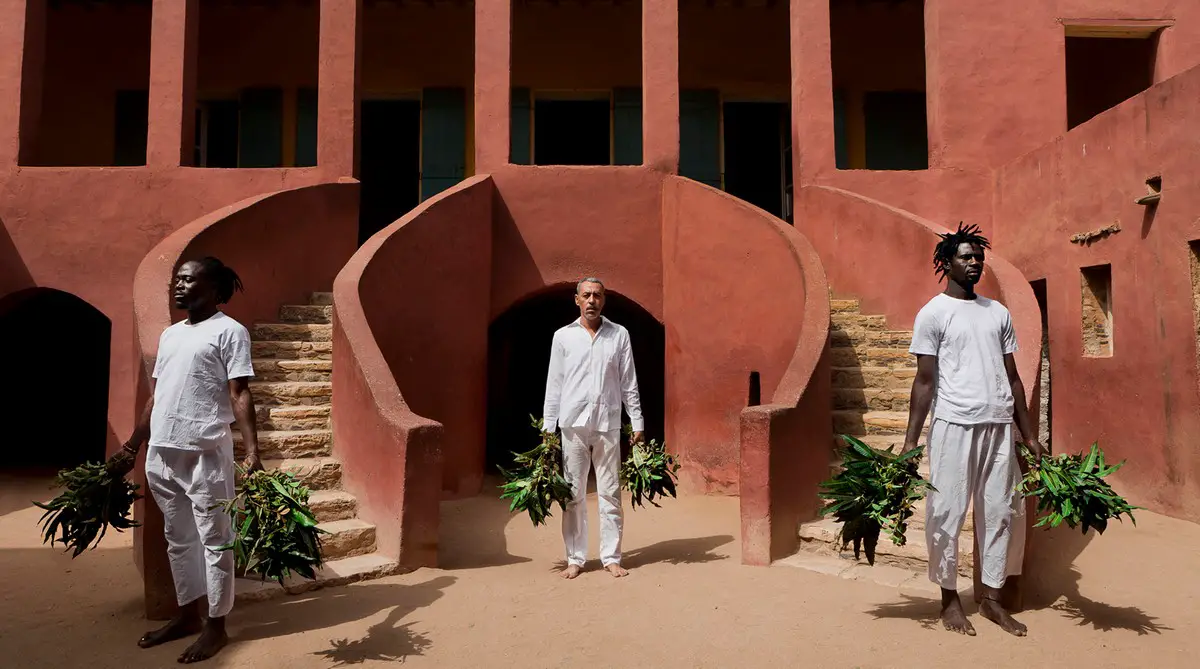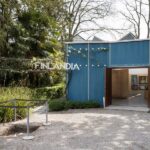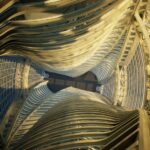Brazilian Pavilion at the Venice Architecture Biennale, Fundação Bienal de São Paulo Italy Exhibit Design News
Brazilian Pavilion at Venice Architecture Biennale 2023
2023 Architectural Show in Veneto, north east Italy, curated by the architects Gabriela de Matos and Paulo Tavares
31 March 2023
Title and theme of The Brazilian Pavilion at the 18th International Architecture Exhibition announced as Terra (Earth)
Curated by Gabriela de Matos and Paulo Tavares
Brazilian Pavilion at the Venice Architecture Biennale in 2023
Gabriela de Matos and Paulo Tavares, curators of the Brazilian participation in the Biennale Architettura 2023:

photo © Levi Fanan and Diego Bresani / Fundação Bienal de São Paulo
Brazilian Pavilion at the Venice Architecture Biennale in 2023 in Italy
São Paulo, 31 March 2023 – The Fundação Bienal de São Paulo announces the project that will occupy the Brazil Pavilion at the 18th International Architecture Exhibition, La Biennale di Venezia (Venice Biennale).
The exhibition is jointly curated by the architects Gabriela de Matos and Paulo Tavares, and features the following collaborators, announced here: Mbya-Guarani Indigenous people; Tukano, Arawak and Maku Indigenous peoples; Alaká Weavers (Ilê Axé Opô Afonjá); Ilê Axé Iyá Nassô Oká (Casa Branca do Engenho Velho); Ana Flávia Magalhães Pinto; Ayrson Heráclito; Day Rodrigues with the collaboration of Vilma Patrícia Santana Silva (Grupo Etnicidades FAU-UFBA); Fissura collective; Juliana Vicente; Thierry Oussou and Vídeo nas Aldeias.
From a reflection on the Brazil of yesterday, of today and of the future, the exhibition places land at the centre of the debate both as a poetic and as a concrete element in the exhibition space. To this end, the entire pavilion will be filled with earth, putting the public in direct contact with the tradition of Indigenous territories, Quilombola dwellings, and candomblé ceremonies.
External view of the Brazil Pavilion during the 17th Venice International Architecture Exhibition:
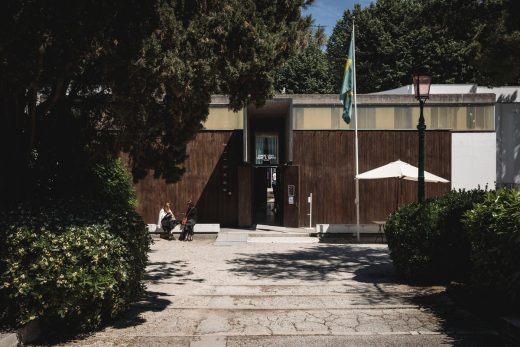
photo © Riccardo Tosetto / Fundação Bienal de São Paulo
“Our curatorial proposal is based on thinking of Brazil as earth. Earth as soil, fertiliser, ground and territory. But also earth in its global and cosmic sense, as planet and common house of all life, human and non-human. Earth as memory, and also as future, looking at the past and at heritage to expand the field of architecture in the face of the most pressing contemporary urban, territorial and environmental issues,” say the curators.
Elements of Brazilian popular dwellings are present at the entrance to the Brazilian pavilion and contrast with the building’s modernist features, such as the fences with the sankofasymbol –pertaining to an African writing system called Adinkra, by the Akan people of West Africa, which has been widely used in fence designs and can be seen in most Brazilian cities, meaning “to look at the knowledge of our ancestors in search of building a better future.”
The first gallery of the modernist pavilion has been named “De-colonizing the canon” by the curators, questioning the imaginary surrounding the version that Brasília, the capital of Brazil, was built in the middle of nowhere, given that its Indigenous and Quilombola inhabitants had been removed from the region in the colonial period, and were finally pushed to the fringes with the imposition of the modernist city. The aim is thus to show an image of a more complex, diverse and plural territory, architecture and heritage of national formation and modernity in Brazil, presenting other narratives through architecture, landscape and heritage neglected by the architectural canon.
Ayrson Heráclito, The Shaking of the Casa da Torre and of the Maison des Esclaves in Gorée, 2015, video installation:
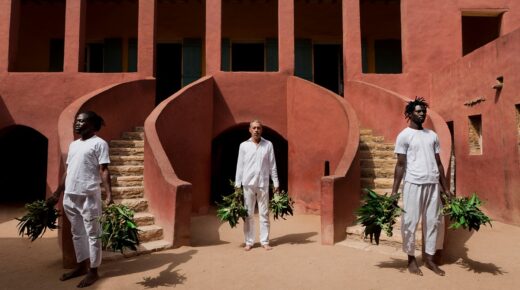
photo © Courtesy of the artist
In a variety of formats, the works that fill the gallery range from the Fundação Bienal de São Paulo Parque Ibirapuera · Portão 3 · Pavilhão Ciccillo Matarazzo 04094-000 · São Paulo · SP · Brasil www.bienal.org.br projection of an audiovisual work by the filmmaker Juliana Vicente, created in conjunction with the curatorship and commissioned for the occasion, to a selection of archive photographs, compiled by the historian Ana Flávia Magalhães Pinto, to the ethno-historical map of Brazil by Curt Nimuendajú and the “Brasília Quilombola map”, the latter also commissioned for the occasion.
The second gallery, named “Places of Origin, Archaeologies of the Future”, welcomes us with the screening of the video by Ayrson Heráclito – The Shaking of the Casa da Torre and The Shaking of the Maison des Esclaves in Gorée, from 2015 – and turns to memories and the archaeology of ancestrality. Occupied by socio-spatial projects and practices of Indigenous and Afro-Brazilian knowledge about land and territory, the curatorship brings forth five essential memorial heritages of reference: The Casa da Tia Ciata, in the urban context of Pequena África in Rio de Janeiro; the Tava, as the Guarani call the ruins of the Jesuit missions in Rio Grande do Sul; the ethnogeographic complex of terreiros in Salvador; the Indigenous Agroforestry Systems of the Rio Negro in the Amazon; and the Iauaretê waterfall of the Tukano, Arawak and Maku.
Ancient writing on stones at the Iauaretê waterfall, 2005:
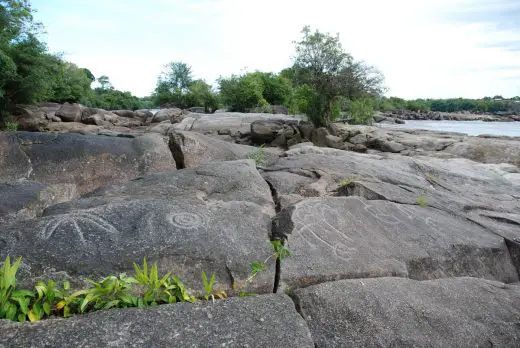
photo © Vincent Carelli/Vídeo nas Aldeias
The exhibition demonstrates what several scientific studies prove: that Indigenous and Quilombola lands are the best preserved territories in Brazil, and in that way point towards a post-climate change future where “de-colonization” and “decarbonization” walk hand in hand. Their practices, technologies and customs linked to land management and production, like other ways of doing and understanding architecture, are located in the earth, are equally universal and carry within themselves the ancestral knowledge to re-signify the present and design other futures, for both human and nonhuman communities alike, towards another planetary future.”
Please see here for a link to the press kit
Brazilian Pavilion at the Venice Architecture Biennale images / information received 310323
Location: Venice, north east Italy, southern Europe
Venice Architecture
Venice Architecture Designs – chronological list
Architecture Walking Tours Venice
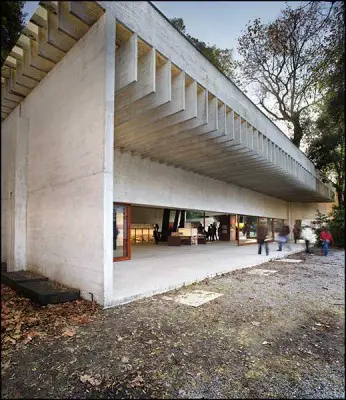
photo : Neale Smith Photography
British Pavilion 2023 at the Venice Architecture Biennale

British Pavilion 2023 Venice
Pavilion of the Holy See at Venice Biennial
Chapels will be dismantled after Biennial and rebuilt in communities that suffered with earthquakes
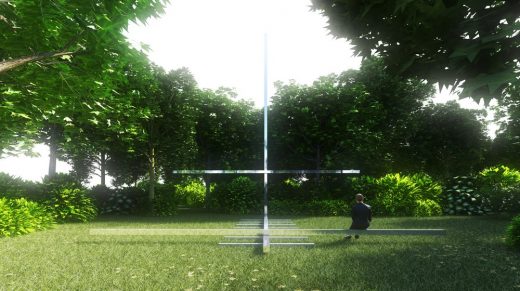
image courtesy of architects
Pavilion of the Holy See at Venice Architecture Biennale
Anish Kapoor, Gallerie dell’Accademia / Palazzo Manfrin
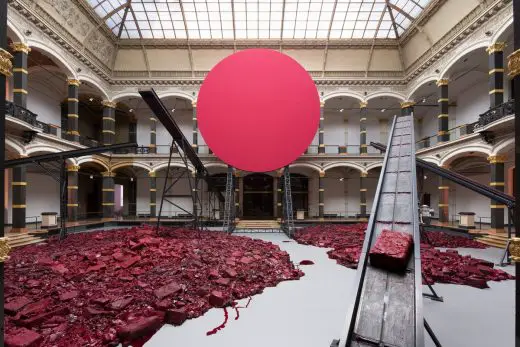
image © Anish Kapoor. All rights reserved SIAE, 2021
Anish Kapoor Exhibition at Gallerie dell’Accademia Venice
Comments / photos for the Brazilian Pavilion at the Venice Architecture Biennale, Fundação Bienal de São Paulo Italy Exhibit Design page welcome

